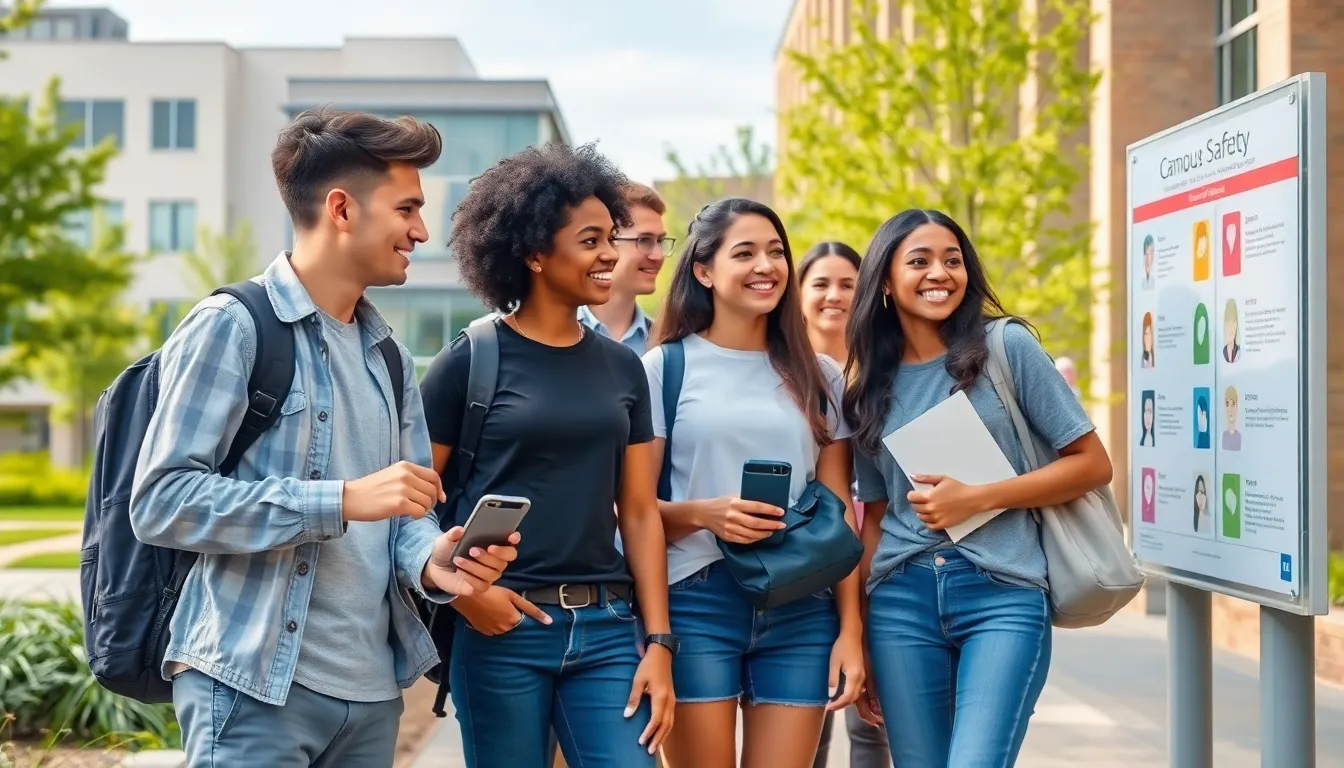When it comes to campus life, safety might not be the first thing on a student’s mind. After all, who wants to think about danger when there are late-night study sessions and pizza parties to enjoy? But let’s face it: a little awareness can go a long way. Keeping safe on campus isn’t just about avoiding the creepy guy in the corner; it’s about creating an environment where everyone can thrive without constantly looking over their shoulders.
From late-night walks to navigating the maze of dormitory halls, understanding campus safety is crucial. It’s not just about following the rules; it’s about empowering students to make smart choices. So buckle up and get ready to dive into the world of campus safety—where knowledge is power and a little humor can lighten the mood. After all, who said staying safe couldn’t be a little fun?
Table of Contents
ToggleUnderstanding Campus Safety
Campus safety encompasses measures and practices designed to protect students, staff, and visitors. Awareness of safety protocols fosters a secure environment for everyone.
Definition and Importance
Campus safety refers to the policies and procedures that promote security within educational institutions. Understanding its significance leads to a safer community. Awareness of potential risks enables students to make informed choices. Safety extends beyond emergencies; it influences academic performance and mental well-being. Engaging in safety initiatives cultivates a supportive atmosphere. Emphasizing safety education empowers individuals to act effectively in crises.
Key Components of Campus Safety
Several elements contribute to effective campus safety. Security personnel play a crucial role in maintaining order and responding to incidents. Emergency response systems, including alarms and alerts, ensure timely communication. Safety programs and workshops educate students about best practices. Environment design, such as well-lit areas and surveillance, enhances visibility and deters crime. Partnerships with local law enforcement create a comprehensive safety network. These components work together, promoting a proactive safety culture on campus.
Common Campus Safety Issues

Awareness of common campus safety issues helps students, staff, and visitors stay vigilant. Challenges like theft, burglary, assault, and violence impact the overall security of educational environments.
Theft and Burglary
The presence of theft and burglary ranks high among campus safety concerns. Statistics show that approximately 20% of college students experience theft during their time at school. Items commonly targeted include laptops, smartphones, and personal belongings left unattended. Ensuring personal property remains secure reduces the risk of loss. Implementing security measures like video surveillance, campus lighting, and reporting suspicious behavior enhances safety. Educational programs also promote awareness about securing belongings and being mindful of surroundings.
Assault and Violence
Assault and violence pose significant threats on college campuses. Data indicates that nearly 8% of students face incidents of physical assault in academic settings. These events often stem from interpersonal conflicts, opportunistic crime, or substance-related issues. Establishing a culture of respect and inclusivity addresses underlying factors contributing to violence. Resources like counseling services, self-defense workshops, and crisis intervention hotlines empower students. Campus safety initiatives encourage reporting concerns and promote proactive measures to create a safer environment for everyone.
Strategies for Enhancing Campus Safety
Enhancing campus safety involves collaborative efforts and proactive programs. Implementing effective strategies ensures a secure environment for everyone.
Collaboration with Law Enforcement
Collaboration with law enforcement remains crucial for campus safety. Establishing partnerships allows for regular communication about security concerns. Engaging local police ensures timely response to incidents, fostering trust between students and officers. Joint training sessions equip campus security personnel with essential skills. Additionally, these partnerships facilitate community policing initiatives, increasing visibility on campus. Regular safety audits by law enforcement help identify areas for improvement. Safety awareness events hosted alongside local police encourage student participation in crime prevention. Each of these steps promotes a safer environment, addressing crime statistics that indicate approximately 20% of college students experience theft.
Implementing Safety Programs
Implementing safety programs significantly enhances campus security. Awareness campaigns educate students about personal safety measures. Workshops on self-defense train individuals in protecting themselves in potential situations. Emergency response drills prepare students and staff for unforeseen incidents. Digital platforms that provide safety alerts keep the campus informed about real-time threats. Campus-wide safety committees involve student representatives, ensuring their voices contribute to safety planning. Peer-led initiatives can also foster a culture of vigilance and support. By investing in these programs, institutions create an environment where safety remains a shared responsibility, directly addressing challenges such as nearly 8% of students facing physical assault.
Role of Technology in Campus Safety
Technology plays a crucial role in enhancing campus safety, providing tools that help create secure environments for students, staff, and visitors. Implementing advanced technological solutions contributes to a proactive safety culture.
Surveillance Systems
Surveillance systems significantly bolster campus security by deterring criminal activities. Closed-circuit television (CCTV) cameras placed in high-traffic areas help monitor real-time activities and respond to incidents swiftly. Reports indicate that campuses equipped with surveillance see a noticeable decrease in theft and violence. Additionally, video footage serves as critical evidence during investigations, fostering accountability. Integrating modern analytics, such as facial recognition or motion detection, further enhances response times and situational awareness.
Emergency Notification Systems
Emergency notification systems act as vital communication tools during critical incidents. These systems allow institutions to disseminate alerts via text messages, emails, or loudspeaker announcements. Consistently informing students and staff can expedite evacuations and secure safety. Research shows that effective notification systems improve community responsiveness during emergencies by up to 30%. Incorporating mobile applications can also facilitate two-way communication, enabling users to report concerns quickly. By ensuring clear and reliable communication paths, these systems significantly enhance overall campus safety.
Tips for Students to Stay Safe on Campus
Students can enhance their safety through awareness and by utilizing available resources. Staying informed about surroundings plays a crucial role in personal safety.
Awareness and Prevention
Awareness of suspicious activities allows students to respond promptly. Maintaining vigilance, especially in poorly lit areas, minimizes risks. Understanding campus surroundings contributes to informed decision-making. Moreover, recognizing potential threats fosters a proactive approach to safety. Sharing knowledge about safe routes encourages collective vigilance among peers.
Utilizing Campus Resources
Students should take advantage of campus resources designed for safety. Campus security offices offer services like escort programs. Utilizing emergency call boxes ensures access to help during critical situations. Participating in safety workshops enhances personal skills and boosts confidence. Counseling services provide support for those impacted by safety concerns. Engaging with these resources promotes a culture of safety on campus.
Prioritizing campus safety is essential for fostering a secure and vibrant educational environment. By cultivating awareness and encouraging proactive measures, students can significantly contribute to their own safety and that of their peers. Embracing a culture of respect and inclusivity not only enhances personal security but also strengthens community ties.
Institutions play a crucial role in implementing effective safety measures and leveraging technology to create a responsive safety network. With the right resources and a commitment to vigilance, everyone can enjoy a safer campus experience. Ultimately, safety isn’t just a responsibility; it’s a shared journey toward a thriving academic community.




